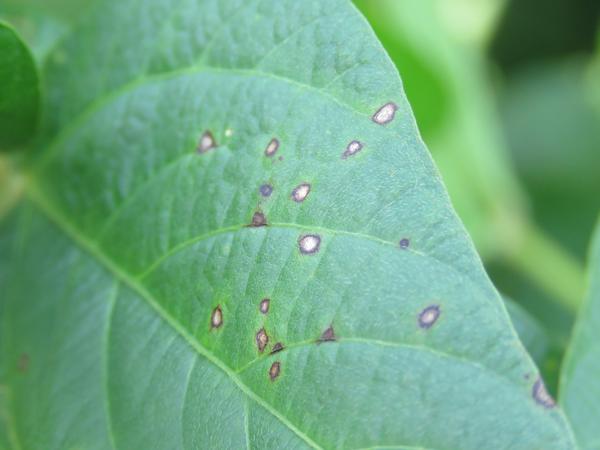Frogeye Leaf Spot
- Scientific Name(s)
- Cercospora sojina
- Type
- Disease
- Leaf Condition
- Leaf Spot
- Leaf Color
- Black Irregular Spots, Patchy Yellow And Brown Areas
- Leaf Location
- Entire, Upper, Lower, Young, Mature
- Pod Condition
- Lesion
- Main Stem
- Necrotic Spots
- Petioles Condition
- Lesion
- Field Distribution
- Random, Low Areas, Localized Area
- Prior Environmental
- Rain, Cool Cloudy
- Season
- Mid To Late Vegetative, Flowering, Pods Present
- Cropping System
- Soybean Followed By Soybean, Conventional Till, Reduced Till
Introduction
Frogeye leaf spot (FLS) of soybean is a common foliar disease in North Carolina with losses reported annually. This disease was first documented in Japan in 1915 and later in the United States in 1924. FLS has historically been more severe in the southern soybean production regions of the United States, but has become an annual problem in soybeans produced in the country.
Pathogen
The causal agent of this vulnerable fungal disease is Cercospora sojina K. hara. The fungus survives in crop debris from previous growing seasons, and produces spores (conidia) when conditions favor release. The fungus can affect soybeans at any growth stage, but symptoms are most commonly observed during reproductive stages.
Host Range
Other legumes as well as some weeds and cover crops may serve as hosts to the fungus.
Symptoms and Signs
Early FLS symptoms are small, dark, water soaked, circular to angular lesion (generally 1-5 mm diameter). As the disease progresses, the lesions expand and becomes brown to grayish with a brown-reddish border. A yellow halo may be observed around leaf spots, but are not necessarily present on all FLS lesions. Lesions may occur on stems as long, elongated gray lesions with purple margins. Pods may also have FLS symptoms, and lesions are circular, and gray with purple margins. In the middle of FLS lesions, small black dots that resemble fine ground pepper, the spores of the fungus, may be observed.
Disease Cycle and Conditions Favorable for Disease
FLS is favored by warm, humid conditions. Frequent rainfall or high humidity (greater than 90% RH) with a temperature range of 77-86°F (25-30°C) are optimal for disease development.
FLS is a polycyclic disease, meaning that it produces multiple spore generations per growing season that can infect neighboring plants and fields. Inoculum survives in crop residues from the previous growing season, or may overwinter in weeds or cover crops. Spores are spread through rain splash to adjacent leaves or through air currents to nearby plants or fields. After harvest, the fungus can survive on or just under the soil surface in crop debris.
Management
Crop rotation with non-host crops (e.g. corn, sorghum, wheat) is encouraged to limit fungal build-up in the field. Practices that encourage the breakdown of crop debris (tillage, deep tillage) help to reduce fungal overwintering. While seed infections are rare, planting certified, disease-free seed may reduce the potential for seedborne infections.
Host resistance is the most economical way to reduce losses from FLS. The Soybean Variety Selection Tool lists the host susceptibility to FLS of commercial varieties that have been evaluated in the Official Variety Testing program.
Fungicides may be beneficial when used on susceptible hosts in years with disease pressure. Fungicide efficacy is rated annually, and can be found on the NC State Soybean portal. Fungicide applications are most effective between R3 and R5 growth stages. Fungicide resistant FLS populations have been identified broadly in North Carolina, and strobilurin fungicides should be avoided as solo applications. To reduce losses of control, rotate fungicide chemistries when spraying multiple times within a season or use a fungicide with multiple modes of action.
Useful Resources
The Crop Protection Network Fact Sheet for Frogeye Leaf Spot has more identification and management information that may be useful.
The NC State University Plant Disease and Insect Clinic provides diagnostics and control recommendations.
The NC State Extension Plant Pathology portal provides information on crop disease management.
The North Carolina Agricultural Chemicals Manual provides pesticide information for common diseases of North Carolina. The manual recommendations do not replace those described on the pesticide label, and the label must be followed.
Acknowledgements
This factsheet was originally prepared by the NC State University Field Crops and Tobacco Pathology Lab in 2020.
- Check out our Facebook and our Twitter!




